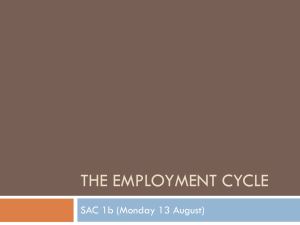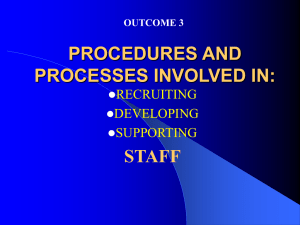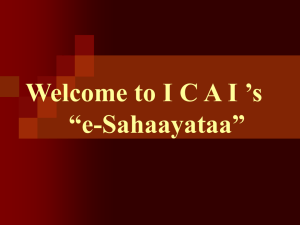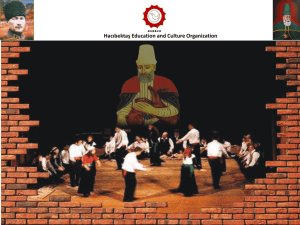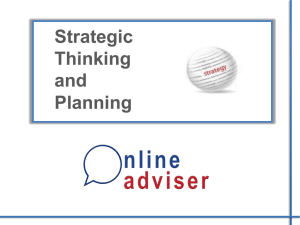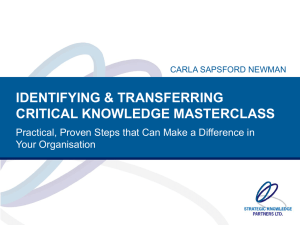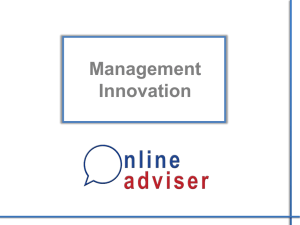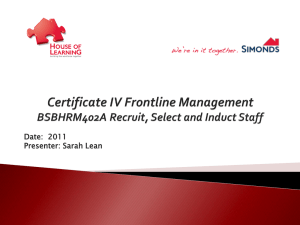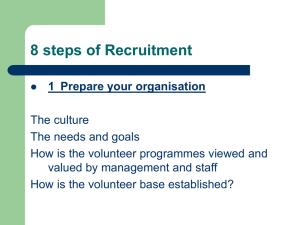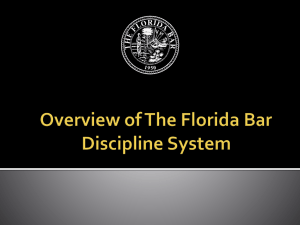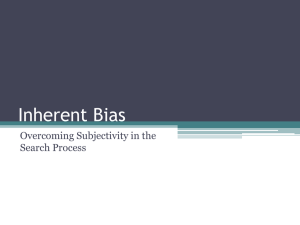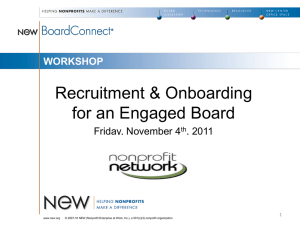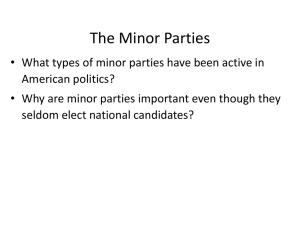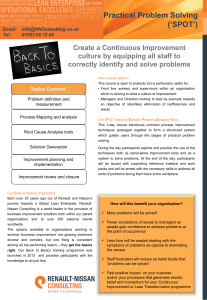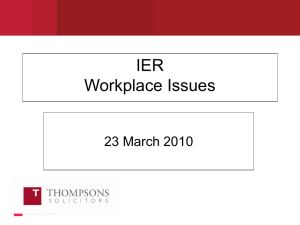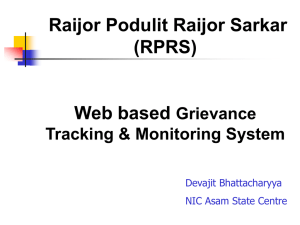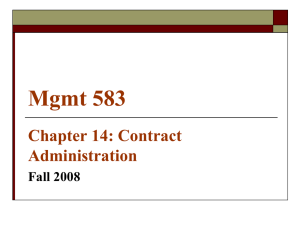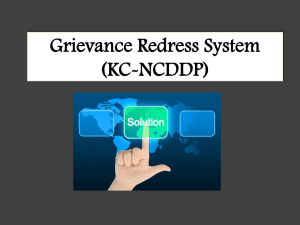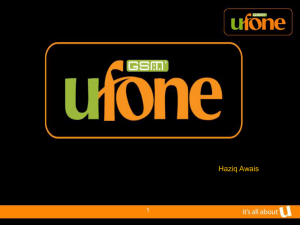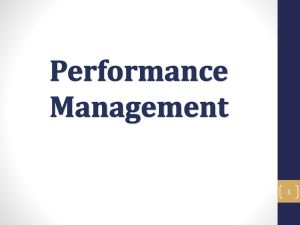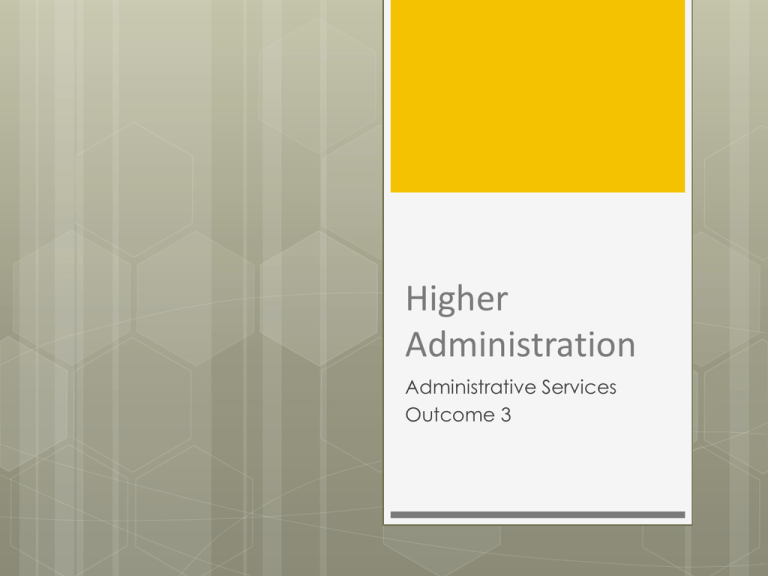
Higher
Administration
Administrative Services
Outcome 3
Recruitment and Selection
Procedures
Recruitment vs Selection
Recruitment
- Getting the right person to
apply for the job.
Selection
– Choosing the right person for
the right job.
The Recruitment Process
Job
Evaluation/Job Analysis
Identification of duties/skills
Do we need to replace this post?
What
if a replacement isn’t necessary?
Can it be outsourced?
Can duties be reallocated?
eg Management Review
Does the role still exist at all?
The Recruitment Process
Job
Description
Duties, Responsibilities, Hours of
Work (and Days), Remuneration,
Location, Line Manager etc
Person
Specification
Skills and Qualities which can be
essential or desirable
Workforce Planning
Being aware of who is employed and
requirements for the future…
Age and Gender
Skills
Staff Turnover
Ethnic minorities and Disabilities
Succession Plan
An Opportunity…
When
a vacancy exists for a job, it is not
automatically filled either by an internal or
external applicant.
Organisations
will take the opportunity to
evaluate the duties and roles of that job
before they decide to fill the post.
Headhunting
Sometimes an organisation will know who
they want for a specific job and they will
approach that person directly and ask
them to apply for the job.
Internal Recruitment
Advantages
Disadvantages
Less Expensive
No new talent introduced
Employees' skills and
knowledge already known
Favouritism?
Increased flexibility with
‘homegrown talent’
Difficult to find the right
person?
Improves morale
(promotion opportunities)
External Recruitment
Advantages
Higher chance of the
right person being
appointed
Fresh skills and ideas
Increased diversity
Disadvantages
More expensive
Recruitment takes longer
Upset existing employees
Extra training may need
provided.
Using a Recruitment Agency
Advantages:
They have access to a wide range of candidates eg some already
on record
Specialist knowledge and experience – eg psychometric testing
HR Departments can focus on other activities such as training and
staff development
Can downsize the HR Department
Disadvantages:
More expensive – may need to pay even if a suitable candidate
isn’t found
Lack of internal knowledge – inappropriate appointments
Process may be impersonal and therefore applicants won’t have a
feel for the organisation before starting work
The Selection Process
Application
Allows each candidate to be easily
compared against others
Often online forms
Curriculum
Forms
Vitae
Summary of qualifications and experience
Often accompanied by a covering letter
Equal Opportunities
It is unlawful to treat one person less favourably
than another, wholly or mainly on the grounds of:
Sex
Martial status
Race
Nationality
Colour
Ethnicity
Disability
Age
Religion
Discrimination
Direct
Discrimination:
“young motivated woman” required
Indirect
Discrimination:
“staff must be at least 5’9” in order to reach
equipment”
Discrimination by association is unlawful (ie just
because you are connected to someone with one of
the protected characteristics)
Bullying or harassment because of one of the
protected characteristics is unlawful
The Short-List and Interviews
Most
organisations will limit the number of
candidates to be interviewed to between
4-8 people.
Interviews:
One-to-one
Number of sequential interviews
Presentations
Preparing for Interviews
Book a room and arrange the seating
Read all documentation
Agree on questions to be asked
Control the interview (Time-keeping)
Put the candidate at ease
Interviews
Benefits
Drawbacks
Meet
and discuss
face-to-face
Candidate
premises
views
Hasty
impressions
Interviewees
nervous and not
perform to their full
potential
Interviews:
The Interview Checklist
A
checklist can be used as evidence to
justify decisions and treat all candidates
fairly.
Testing
choice
can also assist in the selection
Interviews:
The Effective Interview
An effective interview is one where the
interviewer:
Quickly establishes a rapport with the
candidate
Listens to what is said
Asks ‘open’ questions eg “Example of a
time when you showed leadership
qualities?”
Summarises and evaluates the candidate’s
response
Testing
Skills Tests – ascertain if the candidate has the skills and ability to
do the job.
Intelligence Tests – general knowledge, numeracy and literacy.
Aptitude Tests – measure an individual's level of verbal,
numerical and diagrammatical reasoning eg the ability to
prioritise.
Attainment Tests – spelling or typing (WPM)
Personality/Psychometric Tests – explore the candidates
personality and thinking processes. Only qualified staff should
analyse, to avoid misleading results.
Medical Tests – check that the candidate is fit for the type of
work.
The problem with testing is that it can make people feel nervous
and as a result not perform as well.
Making a Decision
References:
Contacted to verify what they have said
Allows candidates to be compared
Previous employer’s opinion
Other
Employment Checks:
eg PVG (protection of Vulnerable Groups)
Informing
unsuccessful candidates
Internet Research
Nottingham University Recruitment and
Selection
Complete the Equal Opportunities Quiz
Staff Development
Staff Appraisal
Employees
who know what and how
much is expected of them are likely to be
more effective than those who are
unclear about their role.
A
meeting held between the employee
and the line manager where a
performance evaluation will be carried
out.
Staff Appraisal
A
plan of development will be made
Reviewed
in 3-6 months, where targets
are checked and further comments and
opinions recorded
Can
be linked to Performance Related
Pay (PRP) – although not popular!
Staff Appraisal - Ingredients
Objective – not a forum for raising problems
and moans
Participative – both the manager and
employee take an active role
Considered – taking account of the strategic
aims of the organisation
Developmental – help to develop the
employee personally and professionally
Staff Appraisal
Discuss and set targets; complete forms
Agree performance criteria
Complete Personal Development Plan
Measure actual performance against criteria
Salary review and/or bonus
Further training
Methods of Appraisal
Management by Objectives:
Emphasises setting of agreed targets, in line with
organisational goals
Competency-based:
Emphasises the importance of assessing how the
work is carried out eg customer service
360-degree:
Uses a variety of people to build an overall profile
eg superiors, peers and subordinates
Successful Staff Appraisals
Identify and match business and personal objectives
Discover employees suitable for promotion
Identify training needs
Control and monitor performance
Assist individuals with self-development
Improve employee motivation
Review salaries or payment methods
Check effectiveness of current work practices
Update job descriptions
Areas for Development
Job
performance
Communication skills
IT skills
Customer service skills
Future training and development
Personal goals eg timekeeping
Career objectives
Measuring Success…
Deadlines
Emails and
Phone Calls
Monthly Sales
Complaints
Against…
Contribution to
Profit…
Complaints
Dealt With…
Benefits of Staff Appraisals
Managers
know what to expect from
employees
Managers develop skills dealing with
employees
Employees can discuss personal and
professional development
Feedback on performance
(Strengths/Weaknesses)
Internet Research
Charted Institute of Personnel and
Development
For further information and fact sheets that
you can download.
Professional Development
Continuing Professional
Development
Staff development looks at what the
employee needs to do to enhance their
current skills, whereas an appraisal
measures their existing ones.
Continuing Professional
Development
Skills and training should be linked to
organisational goals.
Discussion surrounding evidence of targets
being met…
What is needed varies:
Education?
Development?
Training?
Continuing Professional
Development
Education: background academic
knowledge to undertake the job (eg a
degree)
Training: gaining knowledge and skills to
do the current job
Development: identifying future potential
and undertaking education or training to
achieve it
Benefits of CPD
(Lifelong Learning)
Staff
become more proficient at their job
Customers are more satisfied
Staff develop ‘transferable skills’
Less stress on individual
More adaptable to change
Education does not stop once employed…
but the amount of time allocated depends on the
organisation eg Google’s 20% time
Training
Induction Training: the initial introduction to
the organisation
Ongoing training: lists of courses/events
published which may be run in-house
(internal) or off-site (external)
Induction Training
What might be included?
Software used by the business
Meeting fellow workers and a tour of the
premises
Awareness of Health and Safety
procedures
Informing employees of Company
policies
Training Needs Analysis
Organisations work out which courses they
need to offer by conducting a skills scan of
their staff and the results of appraisals and
development reviews.
If an organisation is working towards, or has already
achieved, Investors in People (IIP) status, they will have a
specific policy.
Internet Research
Investigate what is meant by the Quality
Mark ‘Investors in People’.
What benefits does this provide the
organisation with?
What are the key principles?
Types of Training
Blended Learning:
A mix of lecture, tutorial, practical activities and online
material.
Many employees are now encouraged to learn in their own time in places
that suit them eg at Scottish Power staff have access to online materials
which they can work through at their own pace.
On-The-Job Training
Training provided within the organisation
while continuing to carry out work:
Demonstrations
Job rotation
Coaching from a mentor
Working on a specific project
(secondment)
Off-The-Job Training
Training provided outwith the usual working
environment. It may still take place within
the organisation, but is often at college or
other training centre:
Lectures
Online Distance Learning (Open learning)
Case Studies
Individual Projects
In-tray exercises
In-House Training
Advantages
Tailored to suit
organisation’s
requirements
Cheaper than external
training
No travel required
Arranged to fit in with
other organisation
commitments
Disadvantages
Training cancelled if
another emergency
occurred
Training not always
taken seriously –
employees know
trainers
Course may be too
specific
External Training
Advantages
Disadvantages
Networking with other
colleagues
Expensive – time and
money
Improved concentration
(away from working
environment)
Employees may leave if
they gain qualifications
Ability to cascade
knowledge
Course may not be
relevant to organisation
May lead to a formally
recognised qualification eg
HNC
Employees may not pass
the course assessment
Staff Welfare
Staff-Friendly Policies
Work-life Balance:
Employees spending time with families and time for recreation
activities.
Well-being Initiatives:
Head-massage, pilates, yoga, healthy eating options being
introduced, gym membership, support to stop smoking etc
Time to talk:
A counselling service where staff can speak in confidence
Absence management:
How often and how long staff are absent monitored – ‘back to work’
interviews and in-house doctor check progress and health
Internet Research
Visit Scotland’s Health at Work website.
Summarise the benefits of the programme.
Which organisations in the local area have
gained awards?
Counselling
Stress may be related to work or personal issues
(family or home) but anything that affects an
employee’s work performance.
Stress may lead to:
Not sleeping well
Drinking or smoking too much
Over anxious/argumentative
Lack of concentration and poor judgement
Counsellors help with personal problems eg death in the
family/marital problems as well as work/health problems.
All matters are treated in the strictest confidence and no records are
kept in employee files.
Internet Research
Visit the BUPA website and look at the fact
sheet on “Stress in the Workplace”.
Note the causes, triggers and effects of
stress, and how to avoid them.
Grievance and Disciplinary
Procedures
Information provided with the contract of
employment.
Ensures that all employee are treated fairly.
Disciplinary procedures already covered in Outcome 2
Grievances
Raised by employees when they are unhappy about
how they have been treated or about something
that has happened at work.
Have they been demoted?
Paid less than expected?
Change in physical environment?
Change in job conditions?
Sexual harassment?
Bullied?
Grievance Procedures
A Grievance Procedure should:
Make it easy for employee to raise issues with management
Be available in writing and simple to understand
Enable a line manager to deal informally with a grievance
Keep proceedings confidential
Allow the employee to have a companion at a formal
grievance meeting/hearing
Grievance: Procedure Steps
Step 1: inform the line manager of a
grievance in writing
Step 2: meet with the manager to discuss the
grievance with a representative if necessary
Step 3: if the matter is not resolved meet with
a more senior manager
Step 4: be given the right to an appeal
meeting if the employee feels that a
grievance has not been satisfactorily resolved
and be notified of the final outcome.
Internet Research
Grievances should take place within set time limits;
depending on the seriousness of the grievance.
If there is no agreed resolution than matters can be taken
to the Advice, Conciliation and Arbitration Service (ACAS)
to settle.
Visit the ACAS website and search the site for
information on handling grievances.
Take some notes on the importance of clear
procedures for the employee and employer.
Absence Management
Consequences of ignoring short or long-term absences
include:
Loss of productivity and increased costs
Additional work for remaining staff
Repeated absence can cause resentment
An employee’s return to work needs to be managed and
planned. Support must be given from line managers and
the HR Department.
Absence Management
HR should introduce procedures which are sensitive to the
individual concerned.
Keeping in contact with the individual during absence
Arranging return-to-work interviews
Agree staged return-to-work
Arrange meeting with the organisation’s doctor
Using disciplinary procedures for short-term absence
Involve occupational health and rehabilitation
programmes for long-term absence
Higher
Administration
Administrative Services
Outcome 3

